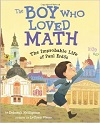|
The Boy Who Loved Math: the Impossible Life of Paul Erdos

Last updated Tuesday, June 6, 2017
Author: Deborah Heiligman
Illustrator: LeUyen Pham
Date of Publication: 2013
ISBN: 1596433078
Grade Level: 2nd (GLCs: Click here for grade level guidelines.)
Date(s) Used: Jun. 2017
Synopsis:
Most people think of mathematicians as solitary, working away in isolation. And, it's true, many of them do. But Paul Erdos never followed the usual path. At the age of four, he could ask you when you were born and then calculate the number of seconds you had been alive in his head. But he didn't learn to butter his own bread until he turned twenty. Instead, he traveled around the world, from one mathematician to the next, collaborating on an astonishing number of publications. With a simple, lyrical text and richly layered illustrations, this is a beautiful introduction to the world of math and a fascinating look at the unique character traits that made "Uncle Paul" a great man.
| Note to readers: |
| • |
Erdos is pronounced "Air-dish". You may want to read the author and illustrator notes (pg 34-37) for more information on Paul Erdos, a fascinating and important person. Definitely read the inside jacket cover to the children before reading the book.
|
| Discussion topics for before reading: |
| • |
How can you tell the boy on the front cover of the book loves math?
|
| • |
How high can you count?
|
| • |
Do you like math? Do you like to add and subtract numbers?
|
| • |
What is a mathematician? (an expert of mathematics; a person who uses math to solve problems and helped us go to the moon. average annual salary is $111,110.)
Vocabulary
|
| • |
improbable--not likely to be true or to happen; tackle--bring down, to make determined efforts to deal with difficult problem; epsilons--a very small positive quantity; genius--a very smart person
|
| Discussion topics for during/after reading: |
| • |
Do you see numbers everywhere? (the number of kids in the class, number of chairs, number of todays date 6-7-17 which equals 30, your home address.....)
|
| • |
How do you use math everyday? (purchasing items, cooking 3/4 flour, 1 cup milk....
|
| • |
What is your favorite number and why?
|
| Craft ideas: |
| • |
Make a Father's Day card using numbers--1 best thing about your father, 2 things you wish to give him, 3 places you have gone with him, 4 of his favorite foods, etc...
|
| • |
Draw a large square with different sized squares inside. Color the different squares. (see page 36 for example) This was a math problem that Erdos did not believe was possible but was proved wrong by his friends.
|
| • |
Draw a picture of your home. school or neighborhood. Write numbers on the buildings for the street numbers, how many people in the home, how many classrooms, how many floors or windows etc...(see page 2-3 for example)
|
| • |
Check our craft ideas for June on Pinterest!
https://www.pinterest.com/readingtokids/june-2017-people-places/
|
*Note: These craft ideas are just suggestions.
You can use them, but you don't have to use them.
You can expand upon them, or add your own twist.
Remember, though, that the focus of your time should
not be on the development and execution of a craft;
the focus should be on the read-aloud and the
enjoyment of the book!
|
